Indeed, yesterday was busy and long, but fruitful. One of the reasons that we are visiting so many projects is to deploy a pilot project for new signage in Iringa. Our work is often a bit of trial and error to find the best solution, and finding different sign solutions at the well sites that are permanent and don’t fade have been a challenge for all our implementing partners.
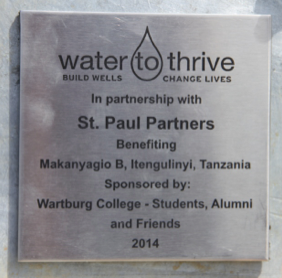
We are putting new signs on all 18 projects near Iringa to pilot-test stainless steel like the one shown above. Stainless steel, of course, does not rust, and the lettering on these signs are chemically etched into it, so it will not fade. In addition, the sign is attached to the well head with a special metal to metal bonding adhesive from 3M that should be as strong as welding.
One of our board members, Lynne Dobson, commented yesterday on Facebook about the buckets being used to carry water. In this area, a bucket is the carrier of choice over jerry cans. The women and young girls generally carry the water on their heads, not their backs, and the bucket is easier to balance than a jerry can.
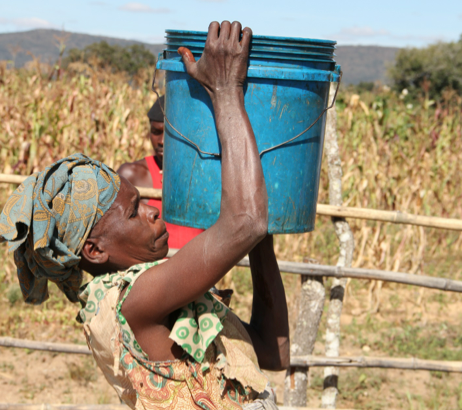
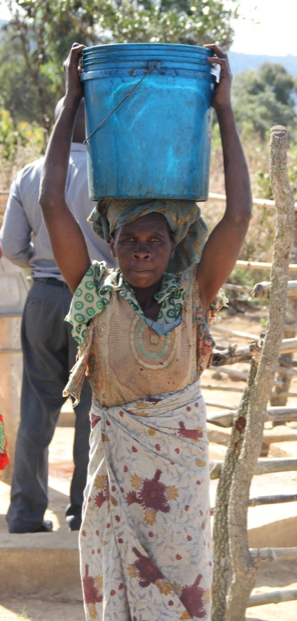
As we approached one of the projects, the woman above had just completed filling her bucket, which holds probably about 60 pounds of water. She could not have weighed more than 110 pounds herself, but in one swift motion, she picked up the bucket and had it securely on her head, and was headed down the road to her home!
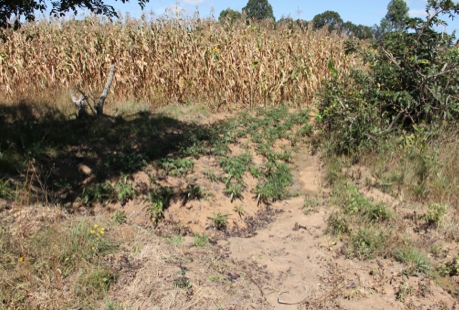
Like most of the areas of our work, this area is populated by small farms, with corn as the crop of choice. You can see the corn field in the background of the picture above. This picture was taken right next to one of the projects and in the foreground you can see the trench that takes the runoff from the project to the two mounds of sweet potato plants for irrigation, using all the water for the benefit of the community.
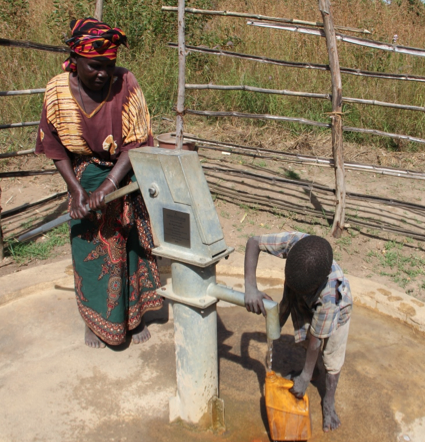
At Gendawuye, we met Swantu Benadecta, pictured above with one of her grandchildren. She is 65, and has lived in this area all her life. Her family consists of nine children, 24 grandchildren and one great-grandchild. She said her family had been collecting from the unprotected river source about an hour’s walk away, and that she had been lucky not to have lost any children to waterborne diseases. Sadly, though, she said their neighbor family had lost two children. She was very thankful that the community now had clean water to ensure better health.
Indeed, yesterday was busy and long, but fruitful. One of the reasons that we are visiting so many projects is to deploy a pilot project for new signage in Iringa. Our work is often a bit of trial and error to find the best solution, and finding different sign solutions at the well sites that are permanent and don’t fade have been a challenge for all our implementing partners.

We are putting new signs on all 18 projects near Iringa to pilot-test stainless steel like the one shown above. Stainless steel, of course, does not rust, and the lettering on these signs are chemically etched into it, so it will not fade. In addition, the sign is attached to the well head with a special metal to metal bonding adhesive from 3M that should be as strong as welding.
One of our board members, Lynne Dobson, commented yesterday on Facebook about the buckets being used to carry water. In this area, a bucket is the carrier of choice over jerry cans. The women and young girls generally carry the water on their heads, not their backs, and the bucket is easier to balance than a jerry can.


As we approached one of the projects, the woman above had just completed filling her bucket, which holds probably about 60 pounds of water. She could not have weighed more than 110 pounds herself, but in one swift motion, she picked up the bucket and had it securely on her head, and was headed down the road to her home!

Like most of the areas of our work, this area is populated by small farms, with corn as the crop of choice. You can see the corn field in the background of the picture above. This picture was taken right next to one of the projects and in the foreground you can see the trench that takes the runoff from the project to the two mounds of sweet potato plants for irrigation, using all the water for the benefit of the community.

At Gendawuye, we met Swantu Benadecta, pictured above with one of her grandchildren. She is 65, and has lived in this area all her life. Her family consists of nine children, 24 grandchildren and one great-grandchild. She said her family had been collecting from the unprotected river source about an hour’s walk away, and that she had been lucky not to have lost any children to waterborne diseases. Sadly, though, she said their neighbor family had lost two children. She was very thankful that the community now had clean water to ensure better health.

About The Author: Water to Thrive
More posts by Water to Thrive